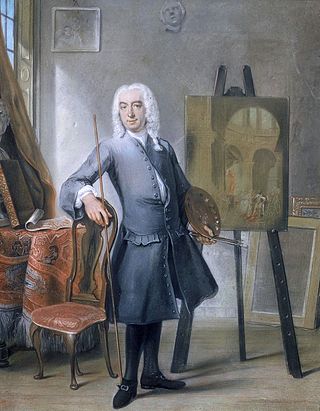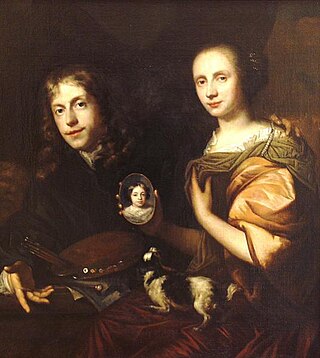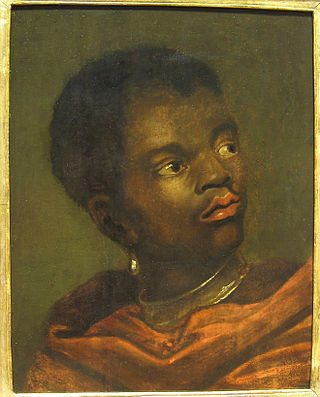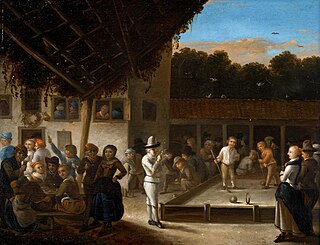
The Dutch West India Company or WIC was a chartered company of Dutch merchants as well as foreign investors, formally known as GWC. Among its founders were Reynier Pauw, Willem Usselincx (1567–1647), and Jessé de Forest (1576–1624). On 3 June 1621, it was granted a charter for a trade monopoly in the Dutch West Indies by the Republic of the Seven United Netherlands and given jurisdiction over Dutch participation in the Atlantic slave trade, Brazil, the Caribbean, and North America.

GovertTeuniszoon Flinck was a Dutch painter of the Dutch Golden Age.

John Maurice of Nassau, called "the Brazilian" for his fruitful period as governor of Dutch Brazil, was Count and Prince of Nassau-Siegen. He served as Herrenmeister of the Order of Saint John from 1652 until his death in 1679.

Adriaen Pietersz van de Venne, was a versatile Dutch Golden Age painter of allegories, genre subjects, and portraits, as well as a miniaturist, book illustrator, designer of political satires, and versifier.

Cornelius Johnson was an English painter of portraits of Dutch or Flemish parentage. He was active in England, from at least 1618 to 1643, when he moved to Middelburg in the Netherlands to escape the English Civil War. Between 1646 and 1652 he lived in Amsterdam, before settling in Utrecht, where he died.

Dutch Golden Age painting is the painting of the Dutch Golden Age, a period in Dutch history roughly spanning the 17th century, during and after the later part of the Eighty Years' War (1568–1648) for Dutch independence.

Dutch Brazil, also known as New Holland, was a colony of the Dutch Republic in the northeastern portion of modern-day Brazil, controlled from 1630 to 1654 during Dutch colonization of the Americas. The main cities of the colony were the capital Mauritsstad, Frederikstadt, Nieuw Amsterdam (Natal), Saint Louis, São Cristóvão, Fort Schoonenborch (Fortaleza), Sirinhaém, and Olinda.

The Ricardo Brennand Institute is a cultural institution located in the city of Recife, Brazil. It is a not-for-profit private organization, inaugurated in 2002 by the Brazilian collector and businessman Ricardo Brennand. It comprises a museum, an art gallery, a library and a large park.

Loango-Angola is the name for the possessions of the Dutch West India Company in contemporary Angola and the Republic of the Congo. Notably, the name refers to the colony that was captured from the Portuguese between 1641 and 1648. Due to the distance between Luanda and Elmina, the capital of the Dutch Gold Coast, a separate administration for the southern districts of Africa was established at Luanda during the period of the Dutch occupation.

Cornelis Troost was an 18th-century actor and painter from Amsterdam.

Frans Janszoon Post was a painter during the Dutch Golden Age. He was the first European artist to paint landscapes of the Americas, during and after the period of Dutch Brazil. In 1636 he traveled to Dutch Brazil in northeast of South America at the invitation of the governor Johan Maurits van Nassau-Siegen. His works were widely collected in The Netherlands, Europe, and Brazil, with the works showing an idealized vision of Dutch colonial rule.
Albert Eckhout (c.1610–1665) was a Dutch portrait and still life painter. Eckhout, the son of Albert Eckhourt and Marryen Roeleffs, was born in Groningen, but his training as an artist and early career are unknown. A majority of the works attributed to him are unsigned. He was among the first European artists to paint scenes from the New World. He was in the entourage of the Dutch governor-general of Brazil, Johan Maurits, Prince of Nassau-Siegen, who took him and fellow painter Frans Post to Dutch Brazil to have them record the country's landscape, inhabitants, flora and fauna. Eckhout is also famous for his still-life paintings of Brazilian fruits and vegetables. His paintings were intended for decoration in a domestic context.

Jan de Baen was a Dutch portrait painter who lived during the Dutch Golden Age. He was a pupil of the painter Jacob Adriaensz Backer in Amsterdam from 1645 to 1648. He worked for Charles II of England in his Dutch exile, and from 1660 until his death he lived and worked in The Hague. His portraits were popular in his day, and he painted the most distinguished people of his time.
Jean Humbert de Superville was a Dutch painter of Swiss and French extraction. Humbert was primarily known as a portrait painter.

Christiaen Jansz van Bieselingen (1558–1600) was a Dutch Golden Age painter.

Lancelot Volders also erroneously known as Louis Volders, Lois Volders and Jan Volders was a Flemish painter who specialised mainly in individual and group portraits but also produced a few history paintings and genre scenes. After training and working in Brussels, he may have worked after about 1700 from time to time at the Stadhouderlijk Hof in Leeuwarden.

Representations of slavery in European art date back to ancient times. They show slaves of varied ethnicity, white as well as black.

Gerrit Lundens, was a Dutch painter known for his genre scenes, portraits and a single vanitas painting. He also made copies after prominent masters, including Rembrandt. He further operated an inn and was active as a wine merchant.

Portrait of a Black Man with a Sword is a circa 1640s Flemish School painting which Sotheby's last sold in London for GDP 34,850 in 2011.

Black Woman with Child is a circa 1650 full-length portrait painting by Albert Eckhout. It is in the collection of the National Museum of Denmark, in Copenhagen.



















